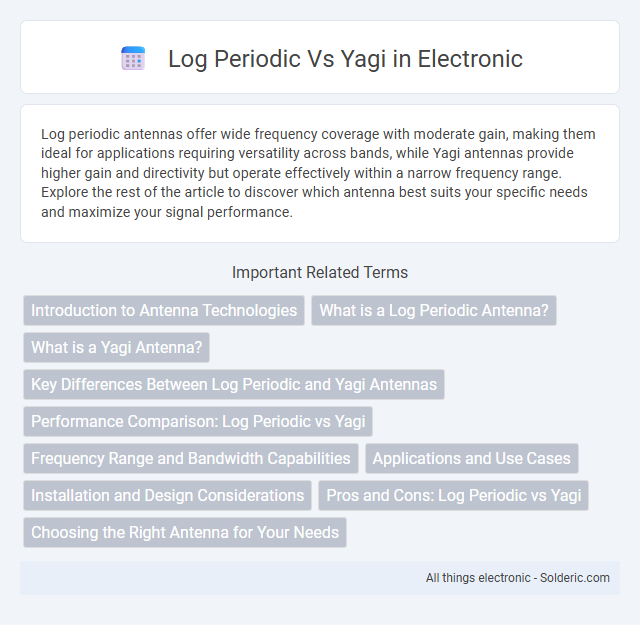Log periodic antennas offer wide frequency coverage with moderate gain, making them ideal for applications requiring versatility across bands, while Yagi antennas provide higher gain and directivity but operate effectively within a narrow frequency range. Explore the rest of the article to discover which antenna best suits your specific needs and maximize your signal performance.
Comparison Table
| Feature | Log Periodic Antenna | Yagi Antenna |
|---|---|---|
| Frequency Range | Wideband, covers multiple frequencies | Narrowband, optimized for specific frequency |
| Gain | Moderate gain (6-10 dBi) | High gain (8-20 dBi) |
| Directivity | Moderate directivity | High directivity |
| Design | Multiple elements of varying length and spacing | One driven element with reflector and director elements |
| Applications | Wideband reception, scanning, communications over broad spectrum | TV reception, point-to-point communication, focused signals |
| Size | Larger, more elements for broader bandwidth | Smaller for specific frequency |
| Impedance | Typically 50-75 ohms, more stable over frequency range | Usually 50 ohms, optimized for narrowband matching |
| Bandwidth | Very wide bandwidth (up to 10:1 frequency ratio) | Narrow bandwidth (typically <10% fractional bandwidth) |
Introduction to Antenna Technologies
Log periodic antennas offer a wide bandwidth and consistent performance across a broad range of frequencies, making them ideal for applications requiring frequency agility. Yagi antennas provide high gain and directivity at specific frequencies, optimized for narrowband transmission and reception. Both antenna types serve distinct roles in communication systems, with log periodic suited for scanning and monitoring, while Yagi excels in focused signal transmission.
What is a Log Periodic Antenna?
A Log Periodic Antenna is a multi-element directional antenna designed to operate over a wide range of frequencies with consistent performance. Its unique structure features elements of varying lengths spaced logarithmically, enabling broadband frequency coverage and stable impedance characteristics. This antenna type contrasts with the Yagi antenna, which is optimized for narrowband applications with higher gain at specific frequencies.
What is a Yagi Antenna?
A Yagi antenna is a directional antenna consisting of multiple parallel elements, typically a driven element, reflector, and one or more directors, designed to enhance signal gain and directivity. Unlike the broadband log periodic antenna, the Yagi offers higher gain over a narrow frequency range, making it ideal for point-to-point communication and broadcasting applications. Its simple structure and ability to focus energy in a specific direction provide improved signal strength and reduced interference in targeted frequencies.
Key Differences Between Log Periodic and Yagi Antennas
Log periodic antennas offer wide bandwidth and consistent performance over a broad frequency range, making them ideal for applications requiring multi-frequency operation. Yagi antennas provide higher gain and directivity at a single or narrow frequency band, excelling in point-to-point communication and signal focus. Your choice depends on whether you prioritize frequency versatility (log periodic) or concentrated signal strength and gain (Yagi).
Performance Comparison: Log Periodic vs Yagi
Log periodic antennas offer a wide bandwidth and consistent performance across various frequencies, making them ideal for applications requiring frequency agility. Yagi antennas, characterized by high gain and focused directivity, excel in single-frequency or narrowband use where signal strength and directionality are crucial. Your choice between a log periodic and a Yagi depends on whether versatile frequency coverage or maximum gain at a specific frequency is the priority.
Frequency Range and Bandwidth Capabilities
Log periodic antennas offer wide frequency range and broadband capabilities, making them suitable for applications requiring consistent performance across multiple bands from VHF to UHF (30 MHz to 3 GHz). Yagi antennas typically provide higher gain but operate efficiently over a narrower, more specific frequency band tailored to particular amateur, TV, or communication signals. The choice between them depends on whether broad frequency coverage or optimized gain and directivity at a specific band are more critical for the application.
Applications and Use Cases
Log periodic antennas excel in broadband applications such as television broadcasting, spectrum monitoring, and research where wide frequency coverage is essential. Yagi antennas are preferred for targeted communication needs like amateur radio, point-to-point links, and television reception due to their high gain and narrow bandwidth. Both antennas serve distinct purposes: log periodic antennas provide versatility in frequency range, while Yagi antennas deliver focused signal strength for specific frequency bands.
Installation and Design Considerations
Log periodic antennas offer greater bandwidth and simpler installation due to their uniform element spacing, making them suitable for applications requiring multi-frequency use. Yagi antennas provide higher gain and directivity but require precise element spacing and alignment, demanding careful design and installation for optimal performance. Choosing between the two depends on your specific needs for frequency range, installation complexity, and directional focus.
Pros and Cons: Log Periodic vs Yagi
Log periodic antennas offer wide frequency coverage and consistent performance across multiple bands, making them ideal for applications requiring versatility. Yagi antennas provide higher gain and better directivity at specific frequencies, enhancing signal strength and noise reduction for targeted communication. Your choice depends on whether you prioritize broadband capability (log periodic) or focused gain and efficiency (Yagi) for optimal antenna performance.
Choosing the Right Antenna for Your Needs
Choosing the right antenna depends on your specific frequency range and gain requirements, with log periodic antennas offering wide bandwidth and consistent performance across multiple frequencies. Yagi antennas provide higher gain and better directivity but are optimized for a narrower frequency band, making them ideal for applications requiring focused signal reception. Evaluating the trade-off between bandwidth and gain ensures optimal performance for tasks such as ham radio, TV reception, or point-to-point communication.
log periodic vs yagi Infographic

 solderic.com
solderic.com